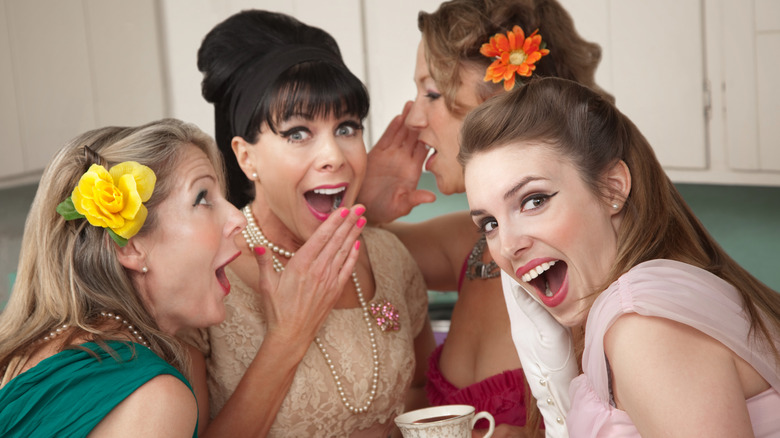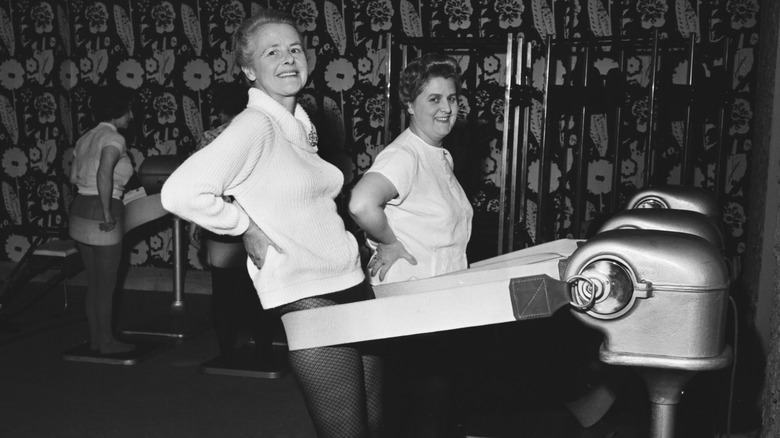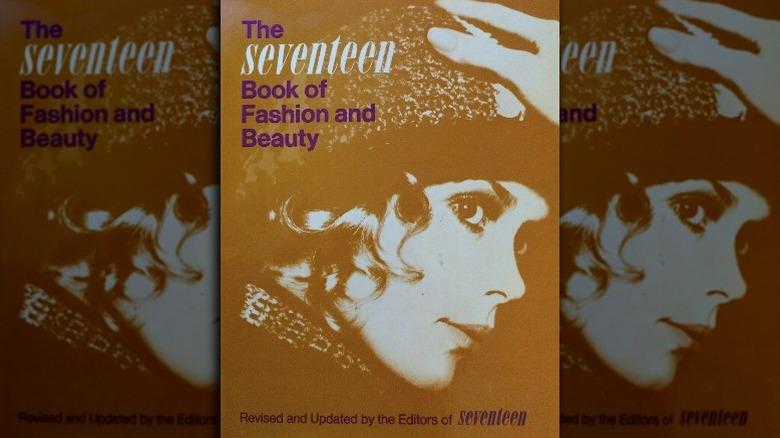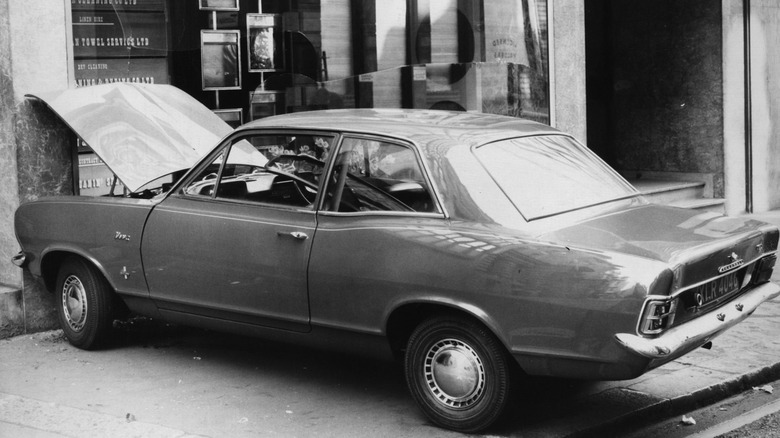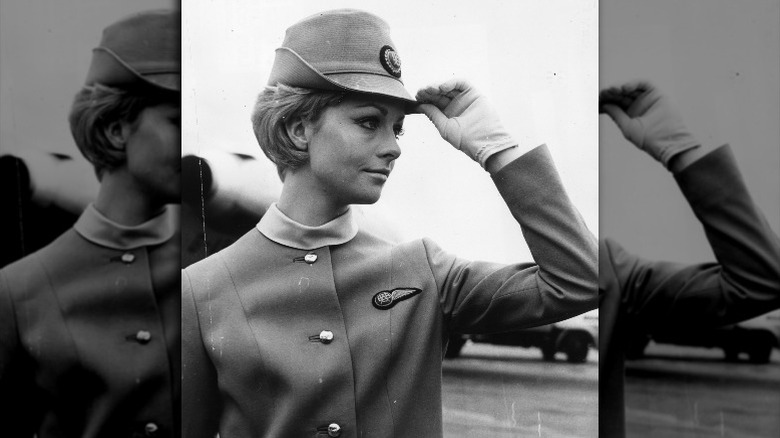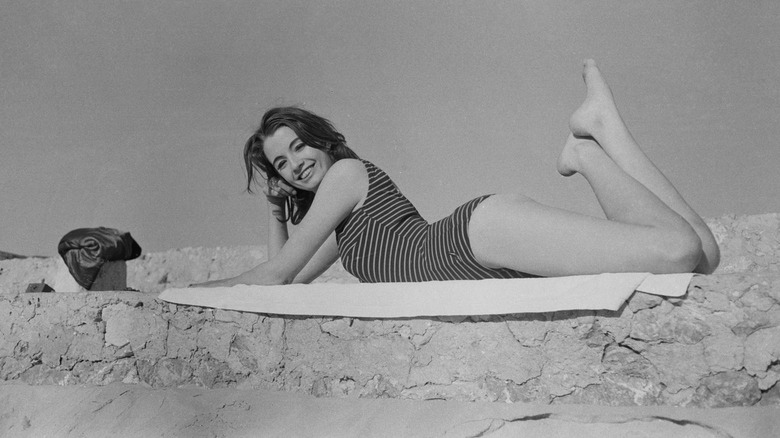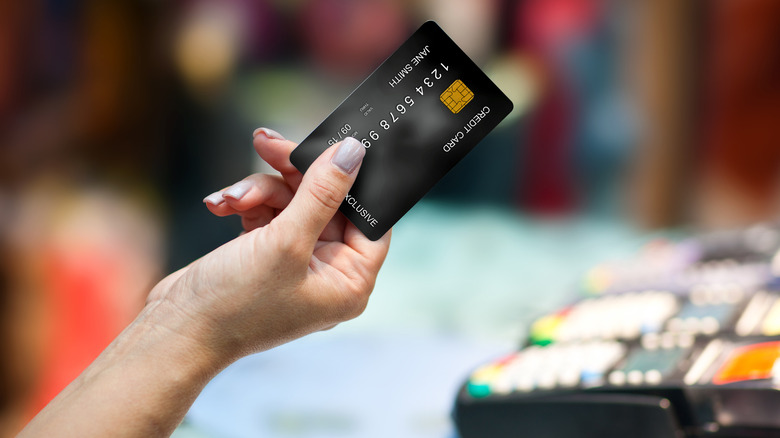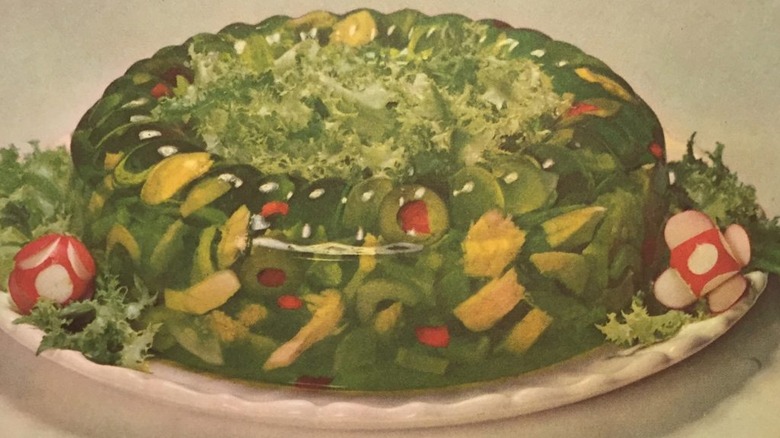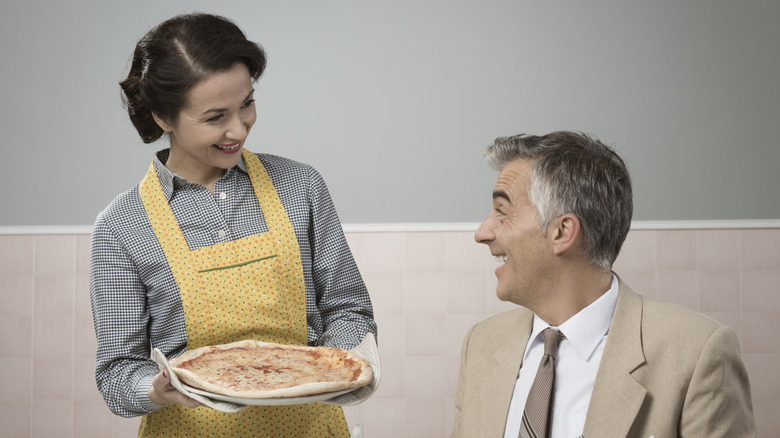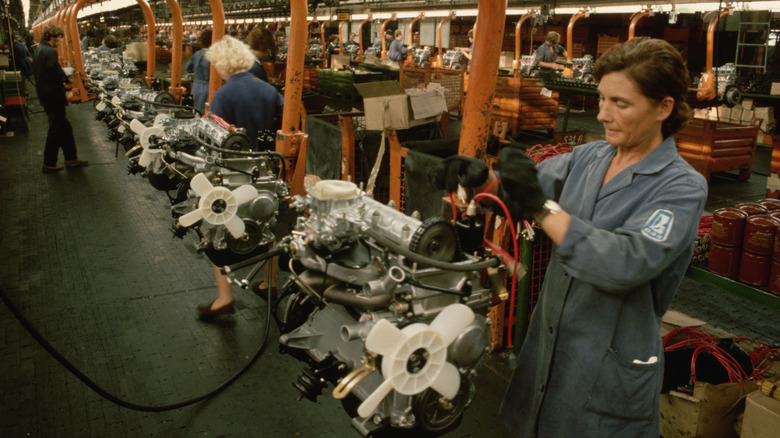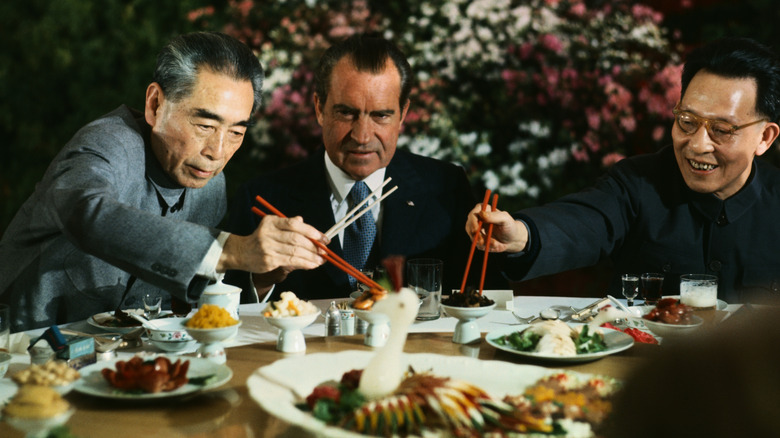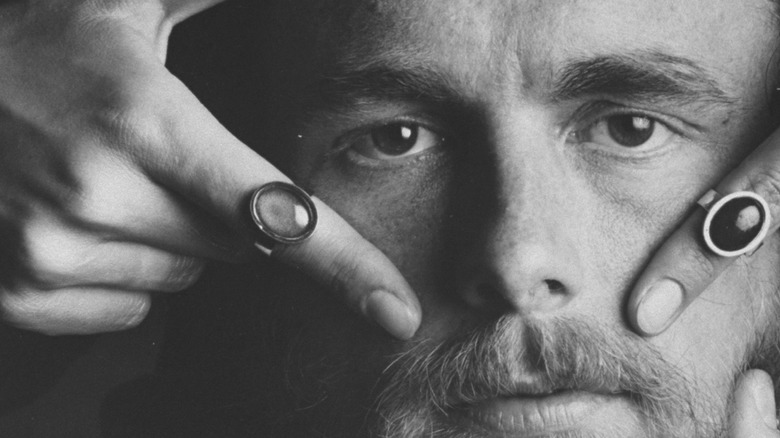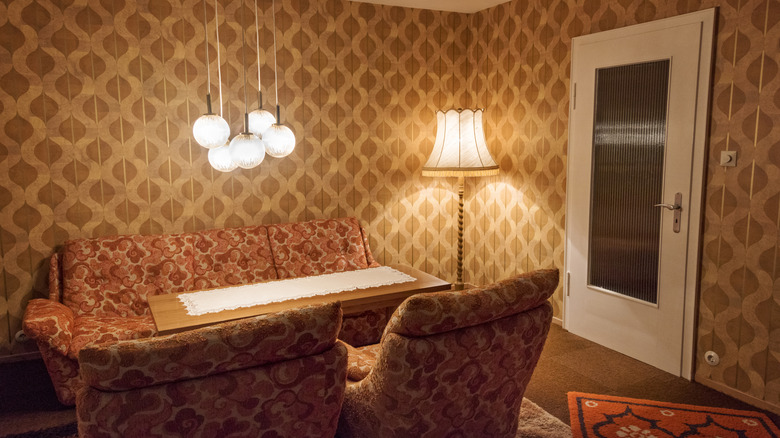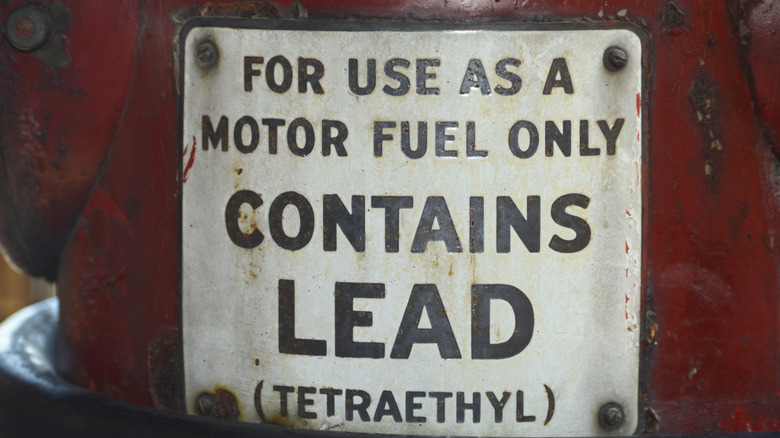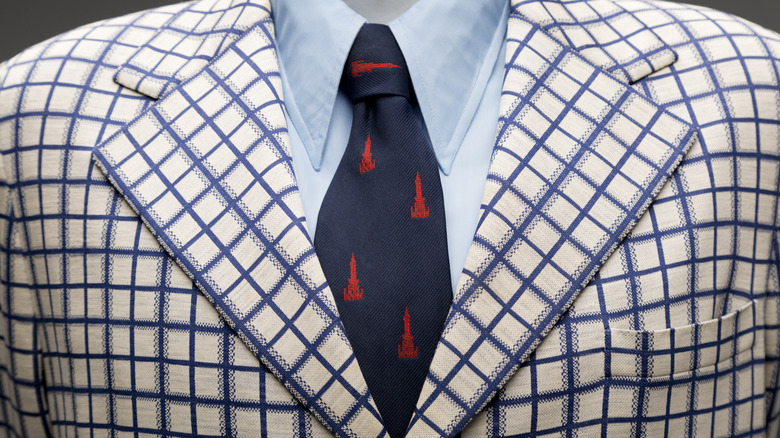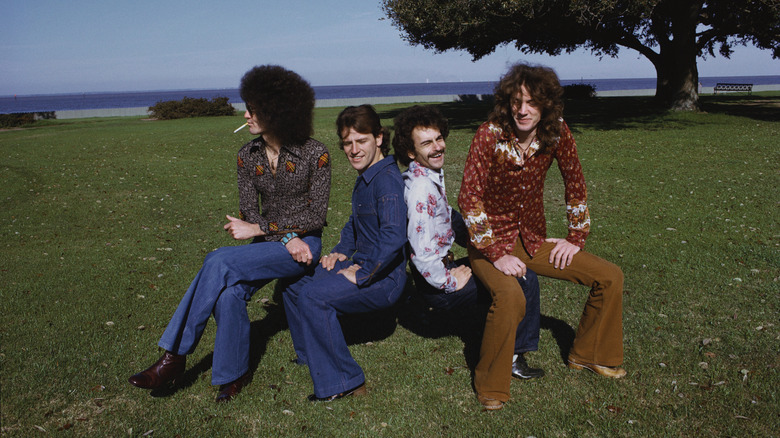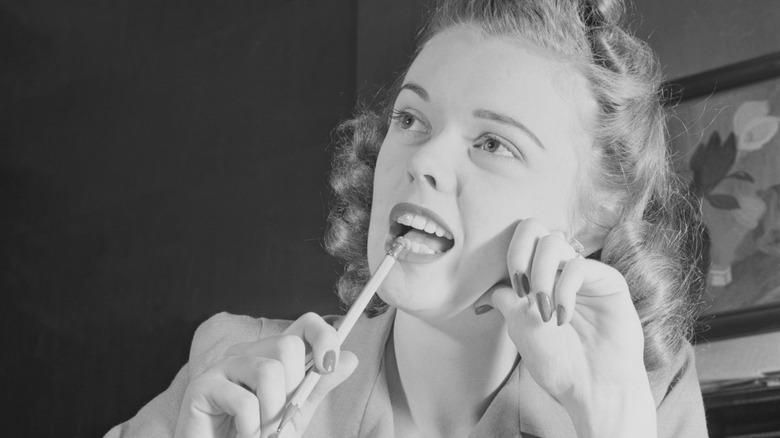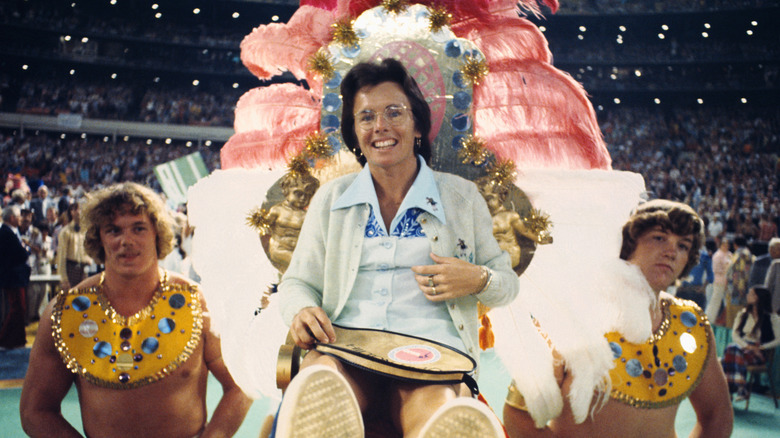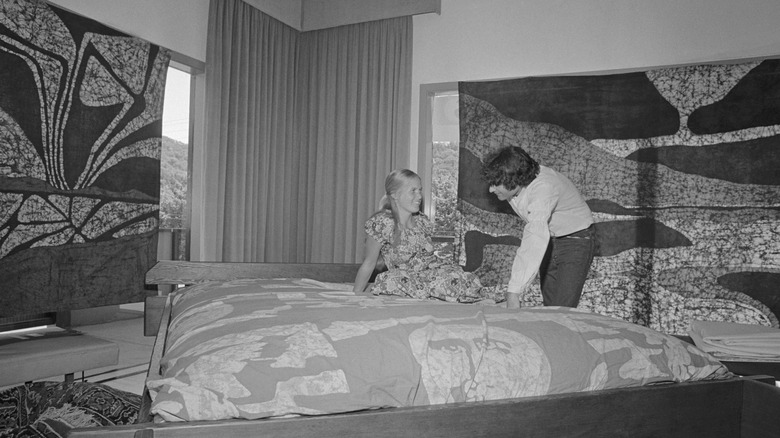Bizarre Things People Believed 50 Years Ago
It's so much fun to look back through time at all the ignorant humans who used to populate planet Earth, while also pretending that in 50 years, people will not also be stifling a sympathetic chuckle as they look back through time at our ignorant selves. That is, if they still feel like chuckling through the gas masks they have to wear every day because we wrecked the planet.
Anyway. It is true that the 1960s and 1970s were full of crazy ideas and ignorant (or maybe just innocent) people who actually believed those crazy ideas. And although it's perfectly appropriate for us to be laughing at our uninformed ancestors as we revisit the past, we should also remember to be grateful that we've moved beyond a world where science hardly knew anything, misogyny reigned supreme, drunk driving was totally cool, and people ate Jell-O with vegetables in it. It was a dark, dark time 50 years ago.
Just shake the fat off
It's been a lot of years since we all believed that the ideal female body was voluptuous and, you know, well-fed. Somewhere along the line we developed a new ideal — women should be thin, and bonus points if you can see a couple ribs or a backbone. Since that day, we've been trying to find the most effective way to drop those extra pounds, preferably with as little effort as possible. In other words, we want to have our slim bodies and eat our cake, too.
History is full of crazy weight loss devices and pills that promise to "melt the fat away while you sleep." But one of the craziest devices ever invented was the vibrating belt workout machine, which was supposed to jiggle the fat off you while you just stood there.
The vibrating belt machine was a must-have device in fitness centers for decades, even though health experts actually knew pretty early on that they were essentially useless. Still, people found them appealing because they thought they had that magic something that delivered weight loss without diet and exercise. Today we know better, so instead of using the vibrating belt machines we just drink apple cider vinegar and order expensive bottles of garcinia cambogia because there just has to be some way to lose weight without all that stupid diet and exercise stuff.
Talk pretty, girls
Yes, in the 1960s women finally decided they'd had enough of the whole stupid "stay in the home and make your husband happy" mandate that had pretty much dominated Western society since the beginning of time. But that didn't magically make all the misogyny go away or anything. No, the 1960s were full of sage advice from grandmothers and magazine editors about the very best way to woo your man and keep him happy after he hath been wooed.
According to Into the Gloss, Seventeen magazine was one of the worst offenders. In 1967, they published a whole book of advice entitled "The Seventeen Book of Fashion and Beauty," which among other things advised young women to develop eating disorders and avoid wearing glasses because looking pretty is way more important than actually being able to see things. But the most bizarre advice of all had to do with a girl's voice. Evidently, it's not enough to be blind and thin, one must also sound pretty. And remember, girls, no one cares what you have to say, only how you say it. "Good speech is more important than the actual words you say ... The sound. The smile. The gentleness, warmth, and vitality. The voice that says, 'I like people. I like you.'" My goodness, Seventeen, but you can just go take your kind advice and stick it in a very warm and dark place. How's that for gentleness and vitality.
Drunk driving was thought of as a rite of passage
Generally speaking, most human beings no longer think that public drunkenness is manly or humorous, and most also don't think that driving drunk is just something people do. But it hasn't always been that way.
According to Russman Law, in the 1960s most people thought that drunk driving was a "folk crime." In fact, it was kind of thought of as a rite of passage, so when parents found out their boy was caught drinking and driving, it was more like a "boys will be boys" thing than an "Oh my god, give me the keys, you're never leaving your room again" thing.
And juries felt the same way, too. In those days, if you were arrested for driving under the influence, you didn't admit guilt — you asked for a jury trial. That's because in most states there was no strict limit on blood alcohol levels, so convicting you wasn't just a matter of giving you a breathalyzer test. The state had to prove that you were not only drinking, but that the alcohol had impaired your ability to safely operate your vehicle. And if you got a sympathetic jury (which most nice young men from "good families" managed to do), then you could pretty easily get an acquittal and just go on with your entitled existence as if nothing had ever happened.
You could just bring your gun to school 50 years ago
In the '60s, young men and their guns went together like young girls and their eating disorders. Public high schools often had shooting clubs and sometimes even gun ranges on campus, and since practices were held after class, kids could pretty much just take their guns to school with them so they could go straight to the shooting range after school let out. Granted, they'd have to turn the weapons over to their homeroom teachers when they got to school so they wouldn't actually be packing heat during a lecture on political science or anything. Safety first.
In New York City, kids would even ride the subway with their rifles. Imagine if this were the norm today — kids showing up to class with rifles slung over their backs and armed teens on public transportation. Let's face it, teenagers aren't exactly known for keeping a level head in a crisis or in a conversation about whether Suzie is using an appropriately gentle, warm, and vital voice, so it kind of seems like the whole crazy standard was a tragedy waiting to happen.
So when did school gun clubs finally start to die out? Well, they kind of didn't. Some schools still have after-school gun clubs, it's just that most modern school administrators recognize the sheer stupidity of allowing armed teens on campus.
Airline stewardesses had to be hot because being hot was literally in the job description
If we told you that in the 1960s and '70s some male executives hired secretaries based on their looks rather than their qualifications, you would probably not be especially stunned. But there was one type of employer in particular who really took the whole "hot employee" thing to extreme levels, and that was the airlines.
Most modern flight attendants can't stand being called stewardesses, and for good reason. According to Vanity Fair, the word "stewardess" harkens back to a time where being capable of attending people on long flights mostly just meant looking awesome in a mini skirt. In those days, you could get a job as a stewardess if you were at least 20 years old but no older than 27, if you were thin and "well-proportioned" and weighed no more than 140 pounds, if you were at least 5-foot-2 but no taller than 5-foot-9, and if you were unmarried and childless. So basically, that meant that the two primary qualifications for serving bags of peanuts and ginger ale were that you had to be hot and available.
Job training included lessons on how to walk sexy, how to stand sexy, how to put on makeup, and how to style your hair, and if you got freckled or tanned or god forbid you got a bruise on your supposed-to-be-unblemished sexy legs, you could be suspended. And you had to retire at 32, because obviously.
Sugar was harmless
Once humans figured out how to refine sugar, there was pretty much no stopping us. Mildly sweetened with honey was no longer enough. No, dessert now had to be so sweet it burned your throat and stayed with you forever in the form of belly fat. And we were okay with all of that because, let's face it, sugar is delicious. And things that are delicious deserve to be more delicious, and in order to make them more delicious you just have to add more sugar.
According to The Guardian, heart disease was rare in middle-aged people up until the 1950s or so, when they suddenly started dropping like flies, you know, if you were shooting flies with a gummy bear cannon. But at the time, everyone blamed saturated fat for the epidemic. Then, in 1972, John Yudkin published the definitive book on the evils of sugar ("Pure, White, and Deadly"), and the food industry went, "Holy hell, we have to shut this guy up," and went ahead and destroyed his reputation. So people went on believing that sugar was totally cool and meanwhile they villainized eggs and other sources of saturated fat, even though countries like France and West Germany had low rates of heart disease despite eating tons of fatty foods all the time. Fortunately for the sugar industry, that was all the time they needed for us all to become irreversibly addicted to sugar, so we'd continue to eat it even despite knowing how terrible it is.
One day, we will all live a life of leisure
The 1960s were such an innocent time. Kids bringing guns to school, airline stewardesses getting fired for weight gain, girls walking into things because they're too pretty for corrective lenses. Yes, if only we could return to those days of sweetness and virtue. Or fast-forward to the days of sloth that the people of that innocent era predicted for us.
The people of the '60s understandably believed that as technology made our lives simpler, we would have more and more free time until things like 30-hour work weeks and one-month vacations would become the norm. We'll pause while you wipe away your tears of hysterical laughter.
Clearly, those soothsayers of the 1960s did not predict the smartphone, which is the modern era's definitive productivity-sucking device, but they also failed to truly understand the sinister thinking of the world's industries. Employers certainly don't want us to idealize a 30-hour work week, so they helped propagate the idea that the citizens of countries where such things are normal are lazy and inferior to us hard-working Americans. Today, banking weeks of unused PTO and never seeing your children is a badge of honor. If only the '60s knew how wrong they got it, they probably wouldn't have ever gone near the '70s.
Unmarried women aren't responsible enough to have credit cards
If you were lucky enough to grow up during a time when being unmarried at 25 did not automatically make you a social pariah, you probably thought it couldn't get much worse than a career where your primary purpose is to make yourself romantically available to airline passengers. But the misogyny of the '60s actually went much, much deeper than that.
It was once perfectly acceptable for banks to ask credit card applicants questions like "are you married" or "do you plan to have kids," but only if the applicants were female. And if you weren't married, the bank expected you to bring a man with you to cosign because everyone knows that girls can't do math and must have big, strong men around so they will always have someone to remind them how to use a decimal point.
Banks could also give women reduced credit limits compared to men who earned similar salaries because everyone knows that girls simply can't resist maxing out their credit card on a single pair of high heels, so it's therefore the bank's responsibility to rein them in. It's not their fault, though, it's that pesky X chromosome.
That ended with the Equal Credit Opportunity Act of 1974. Except it didn't really end, because even as recently as 2012, researchers have found that women still pay more for credit cards than their male counterparts.
Seatbelts were totally unnecessary
Fifty years ago, people thought seatbelts were annoying and oppressive, and for the most part they did not even want those things in their cars. In fact, by 1949, customers were so fed up with those tyrannical seatbelts that many would actually cut them out of their cars with razor blades.
By the early 1960s, seatbelts were optional equipment on most American cars, but that didn't really change anything. Most people didn't want them, and even those who had them mostly didn't use them. By 1966, only 30% of cars on the road in America had seatbelts, and only 44% of the people who drove those cars used them full-time. In 1968, the powers that be finally passed a law requiring seatbelts as standard equipment in all cars, but that still didn't change anything. And it wasn't just because people didn't like the idea of a seatbelt, it was also because auto manufacturers deliberately designed the belts to be uncomfortable as sort of a nose-thumb to government regulations. That persistent hostility was largely the reason it took so long for anyone to actually pass real laws — the first mandatory seatbelt law didn't reach the books until the mid-1980s.
Asbestos was a great building material
Asbestos has a long, dark history of use as a building material, and an equally long and dark history of people pretending like it doesn't cause illness. It was Pliny the Younger, who lived between the years A.D. 61 and 112, who first noticed that enslaved people who mined asbestos and used it in their work often became ill. But they were slaves, so no one really cared all that much.
It wasn't until many, many centuries later that anyone else officially noted that asbestos might cause illness — in 1918, the U.S. government also realized that asbestos workers were dying young. Study after study followed that initial report, but by the 1960s, the asbestos industry was still promoting their product as an awesome building material, and they were still neglecting to provide their workers with safety equipment or even tell them, "Hey, this stuff might kill you" because they wouldn't want anyone to worry about their wonder product. And so it continued to be standard practice to use asbestos building materials in homes all the way through the 1960s and in some cases even longer than that.
It wasn't weird to put vegetables and tuna fish in Jell-O
Perhaps strangest of all was the obsession people in the 1960s had with Jell-O. First, a word about Jell-O: It's disgusting. Just take a step back for a moment and think about what Jell-O actually is — it's the processed, pulverized body parts of pork, cattle, and sometimes even Mr. Ed. To make Jell-O and other products containing gelatin, the hides and bones of animals are rendered in a factory until they produce a wiggly goo that, for some reason, people want to eat. And really, people, even if you don't know anything about Jell-O's origins, nothing that texture should be edible.
Still, the obsession with Jell-O lingers, and you are probably still faced with the horrible choice of eating Grandma's Jell-O salad on holidays or else hurting Grandma's feelings. But it could be worse. It could be vegetables and tuna fish in Jell-O. (The real Jell-O ad above is captioned, no lie, "Ring-Around-the-Tuna — garnished with curly endive and radish roses.")
Yes, 1960s housewives put just about everything in Jell-O, mostly because they were torn between convenience and the horrible possibility that someone might call them lazy because they served convenience food. Shaped Jell-O molds solved this problem because just about any food could become an elegant presentation, including things like savory salads with shrimp or mayo "frosting." One popular cookbook from the early '60s had recipes for "Molded Avocado and Tuna" and "Jellied Veal Loaf." It's okay if you need to barf.
A woman's most important job was to make her husband happy
So you couldn't be trusted with a credit card and you had to talk pretty and walk into furniture and you could be fired for being freckled and you could really impress your dinner guests with jellied tuna in a fish-shaped mold. How could things possibly get any worse?
Well they could, and they did, because women in the 1960s were basically subservient to their husbands, and that's the way everyone thought it should be. And think deeply about what that really said about husband-and-wife relationships in the 1960s — it meant that with few exceptions, men didn't truly respect the women they were married to, which kind of cheapens the whole "love" part of the arrangement.
According to Little Things, there were plenty of manuals for womanly behavior that a wife could refer to if she wanted to make sure her husband knew exactly whose needs came first. (His, obviously.) Housekeeping Monthly's article "The Good Wife's Guide" instructed women to "have a delicious meal ready, on time for his return." Also, you should "touch up your makeup, put a ribbon in your hair, and be fresh-looking." And don't forget, "catering for his comfort will provide you with immense personal satisfaction." And for god's sake, don't assume he gives a crap about anything you have to say, because "his topics of conversation are more important than yours." The '60s were a golden age, truly.
The USSR was in good shape
In the mid-1970s, there was no real reason to doubt the long-term stability of the Soviet Union. In 1961, leader Nikita Khrushchev had promised the arrival of final-form, all-equal communism in or before 1980. As Leonid Brezhnev consolidated power during the 1970s, he tempered expectations, acknowledging that those with the special technical skills needed to advance the USSR in a changing world economy would receive perks, but that the overall trajectory of the country was still toward a communist utopia. Buoyed by a leader who spoke in somewhat realistic terms, the Soviet commentating class was optimistic in the mid-1970s.
This optimism didn't last. Brezhnev had used all his good ideas coming to power, and once he was wholly in charge, both he and the USSR seemed to lose steam, with the Brezhnev years later described as a stagnant era. Slumping productivity and the mismanagement of public money sapped the country's energy, especially as "proper management of public money" is one of the fundamental theses of communist government. Brezhnev's dour cultural conservatism fed an appetite for illicit information from abroad, and policies that favored Russian language and culture fomented resentment in the other republics.
When the ailing Brezhnev died in 1982, he was eventually succeeded by the reformist Mikhail Gorbachev. Gorbachev was unable to stop the rot, and Lithuania declared its independence in 1990, beginning the cascade that led to the dissolution of the USSR.
And so was Yugoslavia
Yugoslavia seemed determined to chart its own course. The Kingdom of Yugoslavia had been pulled together by granting Serbia portions of Austria-Hungary and Ottoman debris after World War I, but the hodgepodge state had fiercely resisted Nazi occupation and shrugged off Soviet domination after World War II. Economic boom years in the 1950s and 1960s and successive reforms to emphasize the Yugoslav state as a federation seemed to put the country on a solid footing.
Unfortunately, some of the prosperity was a mirage, with the economy propped up by excessive foreign borrowing. In addition, old resentments from World War II had been papered over but not addressed: a Croat state had emerged in alliance with the occupiers and committed atrocities against non-Croats in their territory. Not even a victory in the 1989 Eurovision Song Contest could avert the slide toward disunion, and in 1991 Slovenia and Croatia declared themselves independent. Macedonia and Bosnia followed soon after, sparking long years of war and reorganization.
Serbia and Montenegro soldiered on as a remnant Yugoslavia for a few years, but they later rebranded as "Serbia and Montenegro" and then finally split. Yugoslav territory is now under the control of seven governments: Slovenia, Croatia, Montenegro, North Macedonia, internally divided Bosnia and Herzegovina, Serbia, and functionally independent but not universally recognized Kosovo.
And so was Czechoslovakia
Czechoslovakia was another post-WWI project, comprising some culturally similar people whose homelands were in the late Austria-Hungary's north. The new country prospered right after the war, but was Hitler's second external victim, gobbled by Nazi Germany in 1938. Czechoslovakia emerged from the war as part of the Soviet sphere and signed the Warsaw Pact in 1955.
In 1968, a reformist program by the Czechoslovak government was smashed by an invasion by its Warsaw Pact "allies." The new government planned to keep things calm by focusing on both the economy and the rules: The Czechoslovaks would be rich, by Eastern Bloc standards, but also kept more firmly in line by the authorities. Czechoslovakia remained financially comfortable but in the ruling party's grip until 1989, when the communist government in Prague fell to the same reformist wave toppling its counterparts across Central Europe.
And through it all, the Czech and Slovaks had more or less stayed united, at least to external appearances. The two regions had been treated differently by the German occupiers, with Slovakia allowed to operate "independently" as its own puppet state while the Czech lands were directly administered. The 1968 Soviet-enforced counter-reforms had reconstituted the country as a federation of two parts, not unlike its ancestor Austria-Hungary. (Oh, and the Czechs were richer.) In late 1992 the national legislature voted to split the country, and Slovakia raised its new flag on January 1, 1993 — the Czech Republic kept the old flag.
China and the US would never closely cooperate
When World War II ended in Asia, war-weary China immediately turned to finishing its civil war, presumably on the assumption that if people stopped to rest, they wouldn't feel like going on with more fighting. In 1949, Mao Zedong's communists won an almost-total victory, leaving the nationalist forces under Chiang Kai-Shek with control only of Taiwan and a few smaller islands. Anti-communist countries, the U.S. among them, continued to recognize the nationalist government in Taipei as the government of all of China, which aligned neither with reality nor diplomatic necessity.
In 1972, hoping to thaw relations with the mainland government, the United States sent President Richard Nixon on a goodwill visit. Nixon was no real charmer, but neither was Mao, and anyway the men only met once. Nevertheless, the meeting started the process of engagement, even though it would not be until 1979 that formal diplomatic relations were established between Washington and Beijing (and relations downgraded between Washington and Taipei).
Today, the idea of the United States refusing to engage with mainland China is laughable. Relations are seldom smooth, but as the two acknowledged wealthiest and most powerful countries in the world, their engagement is both essential and unavoidable. And, of course, there's money to be made: The countries provide billion-plus-dollar markets to one another.
Nuclear proliferation is limited to the original five countries
In 1964, there were five nuclear weapons states, all major industrial powers on the winning side in World War II: the United States, the Soviet Union, the United Kingdom, France, and China. This seemed like enough nuclear powers for a jittery world, and so the U.S., U.K., and USSR, along with other countries, signed a non-proliferation treaty in 1968 aiming to limit the spread of nuclear capability to other states.
India wiped the smiles off their faces with a successful weapons test in 1974, disturbingly named "Smiling Buddha." The Indian government claimed it was going to use nuclear explosives for major projects like canal digging and mining, which would be dangerously foolish. Fortunately for any civilians drinking from these theoretical canals, it's also a transparent lie, and in the subsequent decades India has only increased its nuclear offensive abilities.
Today, the world contains over 12,000 nukes spread across the nine nuclear weapons states: Russia (heir to the Soviet arsenal), the United States, China, France, the United Kingdom, Israel, India, Pakistan, and North Korea. In 1994, Ukraine, Belarus, and Kazakhstan ceded their Soviet-era nuclear weapons back to Russia, but given Ukraine's subsequent fate, few countries may be eager to give up these terrifying assets in the future.
South Vietnam can stand on its own
In 1968, U.S. and North Vietnamese forces met in Paris to begin looking for a way out of the seemingly endless Vietnam War; unfortunately for many people on the ground, this year also saw the heaviest bombing raids yet. From the beginning of Richard Nixon's first term, he knew he needed to look for a way out, but one that didn't make it look like the United States was cutting bait and leaving South Vietnam to falter. This process took a few years and involved attacking positions in both Cambodia and Laos, which is not traditionally what ending a war looks like.
Finally, in early 1973, U.S. and North Vietnamese negotiators inked a complex but optimistic agreement under which the U.S. would leave and North Vietnam pinky-swore not to invade the south beyond what it already occupied. The hope, at least allegedly, was that South Vietnam could hold out at least long enough for everyone to save face.
It didn't. The ceasefire called for in the Paris agreement was flouted by both North and South Vietnamese forces, and exhausted and misgoverned South Vietnam was visibly on the ropes. In early 1975, North Vietnamese planners began a proposed two-year campaign to gobble up what remained of the south and, for once in the whole terrible war, succeeded with a clearly defined objective ahead of schedule. Saigon, and with it South Vietnam, fell to northern invaders on April 30, 1975, with the country formally united the following July.
Rings could detect your mood
In 1975, inventors Joshua Reynolds and Maris Ambats hit the market with their new product, the mood ring. This gadget answered the unasked question, "Why should jewelry merely be decorative?" If you were unsure how you felt or wanted to broadcast your emotions to those around you by means other than words or facial expressions, the mood ring would change color based on your emotional state. Happy purple, excited yellow, or anxious brown, the stone would reflect your inner feelings.
The mood rings weren't magical, but they were cool (or at least based on marginally interesting science). The stones in mood rings were made of glass or quartz filled with a kind of liquid crystal that changed color based on temperature, and of course the temperature of the stone would theoretically track the temperature of the hand wearing it. (Or of the air around it.) When blood-flow patterns changed as a result of an emotion, the temperature of the crystal would too, changing its color. While there's a germ of truth here, no one has been able to clearly map colors to mental states — but they have adapted similar technology for lipstick and nail polish.
Earth tones added glamour and sophistication to any interior
In 2025, Pantone presented Mocha Mousse as its Color of the Year, an annually selected shade intended to both shape and anticipate trends. Pitched as an attempt to elevate brown and bring it from the merely cozy into the realm of the luxurious, Mocha Mousse is a generally mid-cocoa shade that, despite its alleged hipness, would have been right at home in American design in the mid-1970s.
Because the 1970s were brown. There were golds and oranges and other earth tones, and even the relatively vivid avocado green punched up the palette, but the Nixon years were, in general, brown as a paper bag, with decor and upholstery matching the natural materials such as wood that were then in vogue. You could even dine off brown plates, should your stomach be strong enough. Lest you be drawing a sigh of relief that, whatever new problems the future may be about to throw at us, at least we won't have to confront it from the design equivalent of a pile of dead leaves, be warned: No less an authority than Vogue is saying that brown is back in town and down to clown.
It's fine to put lead in gasoline
If fuel burns too quickly in a combustion engine, it can lead to poor performance as well as an irritating noise known as engine knock. You can limit or prevent this issue by adding substances to the fuel mixture; unfortunately, one of the first additives widely used for this purpose was tetraethyl lead, whose use in gasoline led to high levels of lead pollution throughout the industrialized world. The United States began phasing out leaded gasoline in 1972, followed by Europe over the following years, but lead additives persist in some types of jet fuel.
Lead is very poisonous, especially for young children, and symptoms can be vague enough to mask the damage indefinitely despite its long-term effects. Lead has even been blamed for crime. Studies have connected the kind of brain damage lead can cause to the frontal cortex with aggression and personality changes, and some researchers point to the surge of serial killers in the 1970s and falling crime rates from the 1990s as evidence that lead poisoning drove some antisocial behaviors. As Pulitzer-winning crime writer Caroline Fraser pithily puts it in an interview with Time: "More lead, more murder."
You could lose weight on a wine and eggs diet
Fad diets are usually not good for you, but some at least seem more fun than others. That's certainly the case for the wine and eggs diet, which offers over five pounds of weight loss after a few days of white wine and eggs for breakfast, white wine and eggs for lunch, and white wine and a little bit of steak for dinner. (And black coffee, if you like.) The wine should be dry, ideally Chablis. It certainly sounds like a fun day, but the whole plan is supposed to be followed for three, which veers close to bender territory. The diet was invented, or at least published, in 1962 by Helen Gurley Brown, who would go on to be the long-time editor of Cosmopolitan, and reprinted in Vogue in 1977.
A writer for thekitchn.com tried the diet in 2022 when it had a brief viral resurrection, more as a meme than a genuine suggestion. She reported fatigue, mood swings, and a dislike of poached eggs — but also a 7.2 pound weight loss.
You could become more energetic and attractive on a pineapple diet
The 1970s saw plenty of food fads, and one of the most optimistic was the pineapple diet — or to give it its full name, the Sexy Pineapple Diet. Published as a whole book in 1970 by Danish psychologist Sten Hegeler and his wife Inge, the diet prescribed two days a week of an all or nearly-all pineapple diet (you could eat less than 500 calories' worth of other foods), with a normal diet for the remaining five. Neither Hegeler was a dietician or anything particularly relevant to the task of designing an eating regimen: Dr. Hegeler simply really liked pineapple. He also had no qualms about promoting its near-obsessive consumption to help people allegedly lose weight, feel healthier, and achieve greater sexual vitality.
The full book is out of print, but a writer for Vice Denmark gave it a whirl in 2017 regardless, armed with a secondhand copy. He lost two pounds of water weight off a 6'6" frame and reported being too tired to feel especially sexually vital.
Polyester was the height of elegance
Polyester is the world's most popular synthetic fabric. It tends not to wrinkle and dries quickly — what's not to love? Well, plenty. It's often, though not necessarily, made from petroleum, and its presence in many cloth blends means both that these garments cannot easily be recycled. Additionally, these garments shed microfibers when washed, adding to the increasing load of synthetic chemicals into the environment, and are often manufactured by people without serious workplace protections.
Most of these worries were in the future for fashion plates of the 1970s, aka the Polyester Decade. The smooth feel of the fabric was perfect for the sexy, free-wheeling vibe of the '70s, a sort of dressed-up descendant of the casual late 1960s. Fabrics like polyester especially suited the flowing cuts some people chose in the 1970s, but most of the styles of the decade could be brought to life in its signature material. Moreover, polyester and its sister synthetic materials were cheap, making trendy clothes more affordable for more people, whose budgets could now stretch to include the more playful styles of the decade.
Men looked best in flared trousers and wide lapels
Starting in the 1950s, menswear had slowly become bolder in terms of both cut and color, pushing away from the stereotypical grey suit of the staid businessman. This "Peacock Revolution" flowered in the 1970s, when new fabrics, patterns, and shapes transformed the classic suit and the rest of men's fashion.
The shaggy-haired '70s liked a tall, lean silhouette, and so cuts tended to emphasize these features in those lucky enough to have been born with them. Tight clothes emphasized slenderness (when present), and the wide lapels and landing-strip-sized neckties tried to make the upper torso appear wider and more masculine. The bell-bottom of the previous decade evolved into the slightly calmed flared pant leg. The most iconic menswear item of the decade was probably the leisure suit, an often light or brightly colored suit in a synthetic fabric. History was not kind to the leisure suit, which often seemed cheap or tacky — and often was, even being associated with Leisure Suit Larry, one of the most offensive video game characters of all time.
A pencil could advise you on undergarments
If you don't know what the Pencil Test is, you weren't a woman or girl trying to navigate the fashions and sexual politics of the 1970s. In the 1970s, some women were choosing to go braless (as was their right), and as usual, others were occupying themselves commenting on what these women should do with their own bodies. The public discussion made it into one of the key public forums of America: Ann Landers' column. On December 27, 1971, Landers published a compendium of letters for or against the brassiere, including one that outlined the now-famous Pencil Test. (Landers' commentary was decidedly pro-bra, for the record.)
According to the letter writer (who signed her missive "One Who Flunked"), a woman unsure if she should go without a bra should take a common pencil and place it under one breast. If it falls, the choice is hers; if the breast is able to hold the pencil against the wall of the body without if falling, the tester "fails" (or passes, depending on your taste) and should opt for a bra to keep the twins in line. And should the lady be able to not only keep the pencil in place but also write with it, she may have options in show business.
Richard Nixon was not a crook
On June 17, 1972, five men were arrested breaking into Democratic National Committee headquarters in Washington, D.C. (In the Watergate building complex, hence the Watergate scandal.) Four of these men had ties to the U.S. intelligence service, and the fifth was an employee of an organization working to reelect America's sweetheart, Richard Nixon. Nixon and his allies attempted to muddy the waters around the incident, and Nixon even instructed the FBI to quash its inquiry. Nixon won that November in an absolute romp, burying George McGovern in a 49-state landslide: Massachusetts and the District of Columbia alone opted against him.
Journalists stayed on the case, however, and the subsequent trial of the men arrested at the break-in, along with the establishment of a Senate committee to investigate irregularities in the presidential campaign, meant suspicions of Nixon kept growing. The scandal snowballed, and by August 1974, facing impeachment, Nixon resigned. His vice president and successor Gerald Ford went on to pardon Nixon, a decision that would crater Ford's popularity. He lost to Jimmy Carter in 1976.
Disco was here to stay
The 1970s saw the rise of the much-loved, much-derided disco genre of dance music. Unofficially inaugurated with Gloria Gaynor's "Never Can Say Goodbye" in 1974, disco especially appealed to LGBTQ people and people of color — and arguably, its popularity among these groups drove some of the backlash against it.
Disco evolved from a dance-club open secret to the genre that ruled the airwaves in the mid-1970s, with artists and groups from across the world releasing disco tracks. The mania became so intense that even Broadway legend and grand old belter Ethel Merman herself put out a disco album, which has to be heard to be believed. But gimmicks like this and the associated reputation for commercialization helped sour the broader public on disco.
In July 1979, a baseball game between the Detroit Tigers and Chicago White Sox offered cheaper tickets to people who brought disco records to be destroyed in an on-field gimmick called Disco Demolition Night. Organizers used "too much dynamite," blowing a hole in the field, starting a riot, and opening themselves to allegations of homophobia and racism. Gloria Gaynor won the disco Grammy in 1980 for the immortal "I Will Survive," but that was the first and last year it was awarded.
Take a Quaalude to chill out
If you were feeling wound up in the 1960s or 1970s, you didn't need to bother your doctor about it. Just head to the stress clinic and pick up a prescription for some Quaaludes! Methaqualone had first been synthesized in 1951, and by the early 1960s it had reached the United States as a common and effective tranquilizer. Quaaludes rode a wave of sedative prescriptions in postwar America, when stressed-out people realized that they were but a pill away from feeling calmer. Quaaludes had a reputation for being easy to tolerate, and since the key ingredient was unpatented, anyone (with a fully stocked pharmaceutical laboratory) could produce them.
Quaaludes eventually became so synonymous with recreational use that they earned the flattering but telling nickname "disco biscuits." The inhibition-lowering drug featured in songs by David Bowie and other musicians of the era, but its potential for accidental fatal overdose finally caught the attention of regulators. In 1984, methaqualone was officially outlawed in the United States.
For carpet, the deeper the better
One generation's luxury so easily becomes another generation's punchline, and few consumer goods encapsulate this phenomenon more fully than shag carpet. The long-fibered, deep-piled carpet, at its extreme with a grassland-like ability to conceal an entire human foot, came into fashion in the 1960s, and by the 1970s it had spread, kudzu-like, over interiors from sea to shining sea. Available in a variety of fabrics and all the dubious colors of the area, shaggy shag was where it was at.
Speaking to Apartment Therapy, design historian Sarah Lichtman connects the popularity of shag carpeting to two '70s trends: social change and unrest that may have driven people to choose cozier interiors, plus a sexy sensuality that prioritized the feel of surfaces. Shag carpet was, unfortunately for its longevity as a trend, a nightmare to clean and such a specific look that it very easily became dated. The maximalist, showy 1980s tossed the shag in the dumpster to make way for gleaming (faux-)marble floors and never looked back.
Anyone in the world should be able to exchange a dollar for gold
It's difficult to imagine now, but the 1896 U.S. presidential election turned largely on whether U.S. currency should be totally backed by gold reserves. Pro-gold Republican candidate William McKinley won, signing legislation to place the United States on a gold standard in 1900. U.S. money stayed backed by gold through World War I, and FDR kept a modified gold standard through the Great Depression via some legal gymnastics involving confiscating all investment gold held by private citizens in 1933.
After World War II, the dollar emerged as a mechanism for other countries to stabilize their currencies: Since the dollar was backed by gold, other countries could buy and sell "good as gold" U.S. dollars when they needed to adjust their accounting. If you had $35 in U.S. dollars, you could theoretically show up at the U.S. reserves and get an ounce of gold plopped into your hot little hand. This worked until the U.S. overprinted money to cover expanding social programs and the ballooning cost of the Vietnam War, meaning its gold reserves could no longer cover the dollars in circulation.
In 1971, President Richard Nixon ended the dollar's convertibility with gold. Gerald Ford repealed the ban on private citizens holding gold in 1974, and today the idea of returning to the gold standard is brought up occasionally by anti-inflation advocates who find themselves without plans on Friday night.
No woman was a better tennis player than Bobby Riggs
1973's touted Battle of the Sexes was something of a Rematch of the Sexes, really. The challenger, a sexist also-ran named Bobby Riggs, had been braying about the unseriousness of women's sports and offered to square off against the best female tennis players. His call was first answered by the aptly named Margaret Court, who didn't care much about feminism or getting ready for the match. Court accepted the challenge, the gimmicky Mother's Day scheduling, and the roses Riggs handed her — and lost the match.
Fortunately for American women's tennis, Billie Jean King was ready to avenge Court's loss. King had a successful track record of agitating for better pay for female athletes, even getting Philip Morris to sponsor a rebel tournament for women who had walked out of an earlier competition that offered them a fraction of the men's payout. King out-gimmicked Riggs at the rematch, arriving carried on a litter by four shirtless, well-built young men.
King walloped Riggs. Not only did she outplay him on the court, it was a very public whipping: 48 million Americans had tuned in to watch the match, and they saw King notch a decisive win for the ladies' side.
It was comfortable and cool to sleep on a waterbed
Say what you will about filling a mattress with water, it's a more appealing idea than some of the rejected concepts, which included cornstarch and gelatin as filler. The winning idea — using one of the most abundant substances on earth instead of second-tier kitchen supplies — was presented as a master's thesis in design in 1968 by groovy entrepreneur-to-be Charlie Hall. Hall wasn't the first to have the idea, but he was the first to imply an ooh-la-la sexiness that was key to the waterbed's marketing in the 1970s. Soon, the waterbed was a surefire fad, with sales roaring until the late 1980s.
With a waterbed, you were always a puncture away from catastrophe, and filling them required a hose. They were heavy, hard to clean, and even harder to move. Whether people really enjoyed trying to sleep through life-raft-like rolling or making love while managing tidal action is a question only those individuals can answer, but declining sales imply that the novelty wore off.
